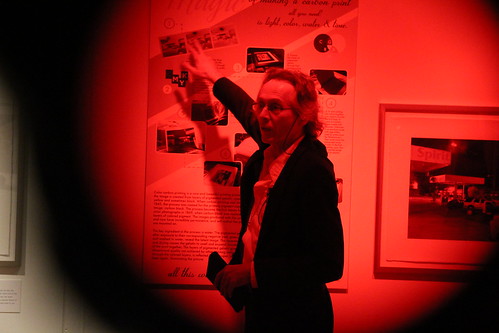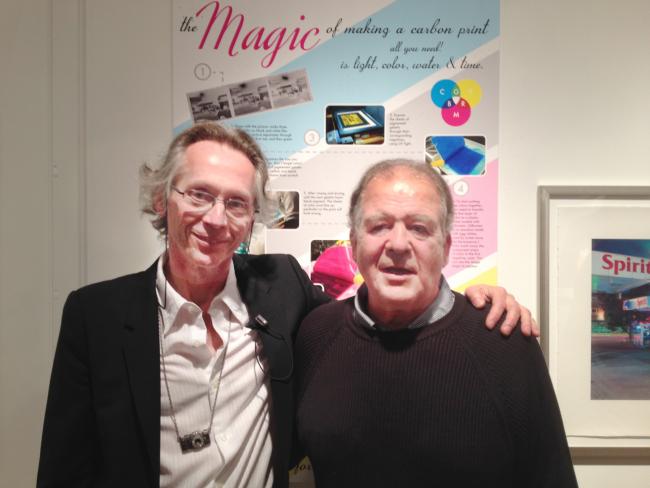At Large in Ballard: Dusk to Dawn Love Letter to Ballard
Tod Gangler and Charles Berger.
Wed, 09/24/2014
by Peggy Sturdivant
After attending the opening of the Nordic Heritage Museum’s new photography exhibit “The Color of Time,” with Ballard as its subject, I was torn about how to do it justice. “Are you going to write about it?” neighbor and original NHM member James Hafterson called out to me after the event, “because I think it’s the best exhibit I’ve ever seen there.”
For the last four years Tod Gangler has been walking through the streets of Ballard at night, a neighborhood he thought that he already knew, using tri-color photography and a color carbon printing process that returns to the origins of photography circa late 1800s France. Like Daguerre in his day Gangler photographs with long exposures, as long as an hour at a time, for each of three separate black-and-white photographs which he later prints through a process that takes eight days (after having a single negative made in Portland).
The laborious process has taken Gangler some 30 years to master, but allows him to document change. It’s time captured and then printed so that appears multi-dimensional. Of his body of work in “The Color of Time: Ballard from Dusk to Dawn,” Gangler says simply, “It’s a love letter to Ballard.”
In turn, it’s a love letter that I want everyone in Ballard to receive, by way of getting themselves to the Nordic Heritage Museum between now and November 16, 2014.
On opening night Gangler credited fellow artist Mona Lang, a painter, who told him to get out there to photograph Ballard before it ‘all changes, as it changes.’ “It’s going, it’s going,” she recalls telling him. In turn she introduced his work to NHM’s then-curator Lizette Graden who saw the project’s relevance to the museum.
Gangler had been taking snapshots but Lang’s directive inspired him to turn his lens onto the parts of Ballard that seemed most likely to disappear, including the marine industrial area along the Ship Canal where the new Nordic Heritage Museum will be located. So Gangler set out in the hours between dusk and dawn.
Who but patrons at last call or the homeless camped along the railroad tracks knew that Gangler was among them, a renowned photographer with the patience of decades spent mastering this form, willing to spend up to an hour per shot, and then another two, in order to have three original negatives that he could later overlay. Through these long exposures, a special negative and then a process that involves gelatin, colors one at a time, water baths and the meeting of gelatin-covered plastic and watercolor paper come photographs that become three-dimensional compositions.
As an artist who became fascinated by this nearly lost process (only four individual photographers doing it worldwide) Gangler approached the project as a way to capture historic Ballard and translate its ‘moment of change’ into visual language. The buildings are solid in the photographs, but all movement that occurred during his long exposures is ghostly, whether a car’s headlights, a woman who stepped outside of a bar, even the moonrise.
Gangler photographed some places that are indeed now gone, The Viking, Coppergate…or places that I’ve never entered such as Golden City. Some of the opening night guests seemed to have stepped out of the photographs, in which dark and had been light, light had become dark, and then a full spectrum of colors overlaid. The Lockspot owner was present, as was a bartender from Hattie’s Hat.
 "Jesus Saves," by Tod Gangler
"Jesus Saves," by Tod Gangler
Briefly addressing the attendees as a whole Gangler said he felt the “magic” of tricolor photography and color carbon printing would be the “perfect lens to look at our neighborhood.” The synchronicity of Ballard’s founding and the development of the carbon printing process were a bonus, or else meant to be. “We have a choice,” Gangler said of his work to document Ballard at yet another point of momentous change, “to think about and create our future Ballard. We have an opportunity to make something so exceptional.”
 Tod Gangler passed around colored lenses during his exhibit presentation to describe his tricolor photography. Photo by Shane Harms.
Tod Gangler passed around colored lenses during his exhibit presentation to describe his tricolor photography. Photo by Shane Harms.
Even as Gangler was congratulated and complimented by the 200-some attendees his excitement never seemed personal, rather it encompassed Ballard and the opportunity to showcase it for others who love it, past, present and future. Another practitioner of the process, and one of Gangler’s teachers, Charles Berger, had traveled from Santa Cruz for the opening of “The Color of Time.” Unrecognized as another master by the most of the attendees Berger was able to serve as personal guide to the quality and yes, uniqueness, of the work. “Many are called, but few are chosen,” he said, watching Gangler use his hands and body to speak to guests, passion unmasked.
Berger, another practitioner of the 19th century process, pointed out nuances in the photographs to me, created by steps of complicated chemistry. At face value they are simply stunning works of color and composition, giving us new takes on familiar places like Mike’s Chili and the railroad trestle bridge. “He knows what he wants to do,” Berger said. “He’s been making handmade materials in his basement. Now look, look how exalting our lives and works can be.”
 "Mike's Chili Parlor," by Tod Gangler.
"Mike's Chili Parlor," by Tod Gangler.
The day after I was still struggling with how I was going to write about the exhibit, while ordering everyone to see it. For those of us who have lived anyplace that we love for a long time, or have even just arrived, the photographs will speak to each of us as places loved. Other artists will notice the colors created by overlay on negative space or the depth created by a process that actually splits a molecule in half. Out-of-towners will notice the beauty of buildings but not be able to put their finger on the sense of change. Those of us who have ever loved the place that became Ballard in all its murky stages will be able to read the love letter.
In retrospect Charles Berger, New York-born, now of Santa Cruz by way Iowa and a fellow photographer summed it up as he looked over the three rooms of his Ballard-based friend Tod Gangler’s new work, “These are my babies,” he said.
The Color of Time: Ballard from Dusk to Dawn runs through November 16, 2014. The museum is at 3014 NW 67th Street. www.nordicmuseum.org. Through September 30th an installation by French artist Laurence Landois is being shown in conjunction with the Gangler exhibit. “Home Sweet Home” was inspired by the Edith Macefield house.
Tod Gangler will give a lecture on the history of early photography and his own work at the Nordic Heritage Museum at 7 p.m. 10/18/14. During the exhibit the NHM will also offer a lecture on caring for heirloom photographs (10/18) and a community event “Ballard Best Place Ever” (10/23).
Craft School: Workshop & Lecture: Caring for Your Heirloom Photographs
Saturday, October 18th, 2:00-4:00pm
Join a member of the Museum’s collections team for a workshop on the care, display, and storage of both digital and non-digital photographs and a behind-the-scenes tour of our photo storage.
Photographs need proper care to survive. Learn the museum’s tricks and techniques for caring for our photo collection and the different ways to safely show or store photographs. In conjunction with the Color of Time exhibition, our curators will show you the different tools and accessories they use on the museum’s photos, and give you tips for adapting them for home use. You’ll get to see the way our curators store the museum collection on a special tour of our storage space.
You will go home with multiple handouts and other useful information on caring for important images.
Cost: $20 members / $25 non-members. Purchase tickets here:
To attend, call 206.789.5707 ext. 10.


